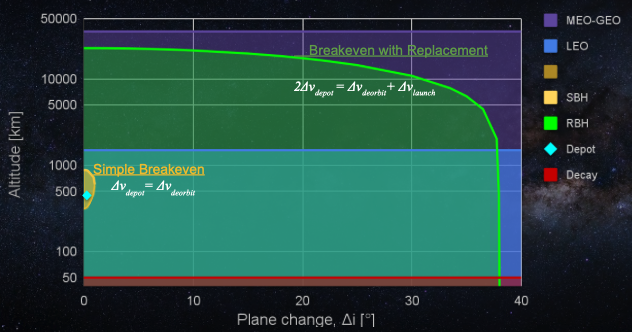It's no coincidence that this article shares its title with Daniel Suarez's latest sci-fi thriller in the Delta-V series. Don't worry- no spoilers here. One key quote from the Critical Mass novel is "The entity with the most mass in orbit, wins." It is in essence one major theme for the well researched book.
I want to unpack that statement, because even though it comes from a work of fiction, it contains more than a grain of truth; more like several kilotonnes.
There are multiple reasons why mass on orbit is so critical:
Mass = Ownership
Although the Outer SpaceTreaty specifically says outer space is the domain of "all mankind", it is also structured to a) grant right of way to the satellite first in orbit (right of transit) and b) retain sovereign ownership in perpetuity for hardware placed in orbit (mineral rights). These two aspects amount to orbital real estate ownership, staked by orbital mass.
Mass = Mobility
The rocket equation demands that mass be sacrificed to the gods of motion. Every orbit has an associated velocity that balances centripetal acceleration with Earth's gravity. To change orbits, a change in velocity, or Δv ("delta vee") is required to move your mass, at a cost of some of that mass. Because all propellant to date is made on Earth, Δv starts around 9 km/s just to get into orbit in the first place. Dependent on the rocket characteristics, the cost per kilogram per delta V works out to about $9,000 - $50,000 sec/kg-km).
Weird units, but useful.
Mass = Capability
While technology allows more functionality with less mass (satellites have been getting cheaper, smaller, and lighter), everything useful, including software and information, requires hardware. Hardware means mass. In the case of satellites, functionality is tied directly to power, which in LEO is photovoltaic (PV) solar panels. Currently PV is roughly about 1 kg/kW.
Mass = Resilience
So far, no one has invented force fields, so there is only one way to stop radiation, bullets and micrometeoroids. That is: putting up a shield made of - you guessed it- mass. To most clearly understand how it works, let me ask a simple question: would you prefer to be the bug, or the windshield?

More mass is also more momentum, which in LEO means less orbital decay due to atmospheric drag.
If orbital mass is so critical, why are we deorbiting?
There's no denying that Low Earth Orbit (LEO) is getting busy. Is it fair to say it's crowded? LEO is not like a parking garage, where you can cram cars in and only have to leave space for the valets to open the doors. It's not even like a racetrack, where all the cars are going in the same direction at high speed. It's more like a bunch of intersecting race tracks. When there's not much traffic, no big deal, you just time the intersections to avoid collision. However, we keep adding not just cars, but racetracks and intersections.
When satellites intersect at the same time, it's call a conjunction, and just like with the racecar analogy, when two moving objects try to occupy the same point at the same time, a collision results, with attendant damage. At the hyperballistic velocites involved, particulate debris is generated. Unlike the racecar analogy, the debris cloud does not come to rest right away. In space, it creates a cloud of projectiles that may take years, decades, or centuries (depending on the orbit) to naturally decay into Earth's atmosphere (where it will mostly vaporize). Obviously, when a collision occurs with an operational satellite, there is a loss of function, thus there is an added onus on operational sats to do collision avoidance manuevers (CAM), which incur additional operating costs in maintaining situation awareness, manuever coordination, temporary loss of service, and propellant expenditure.
As a satellite nears the end of its life, the traditional solution is to deorbit it before collisions occur. Nowadays, the end of satellite life is dictated by its ability to do CAM, which is typically governed by its remaining propellant. Beyond the irresponsible option of leaving the satellite cluttering its orbit as space junk, the only alternatives are to either consolidate it with other debris to a graveyard orbit, or to deorbit it. If only the cost of the orbital manuever is considered, then the simple breakeven (SB) cost is as simple as comparing the delta V for deorbit versus a graveyard depot. Currently, the only real graveyard orbit is out beyond GEO, and there are no depots there, nor the technical capability to reprocess materials (which is what Lunexus is working on), which explains why deorbit is the de facto solution.
However, if one considered the idea of replacing the ISS with a depot with refueling, salvage, and satellite component manufacturing capabilities, then the idea becomes feasible for debris close by (inside the yellow region) as shown in the chart below. This is why I keep annoyingly pointing you toward that petition!

This chart shows how critical the inclination is in LEO maneuvers. It's plotted relative to our notional depot plane on the horizontal axis. The vertical shows the altitude above Earth's surface, logarithmically so that we can get a sense all the way out to GEO.
But why are we only looking at single sat end of life?
Satellite deployments are on the increase (doubling approximately every 2 years), so the demand for more capability on orbit is growing. At the same time, satellite life has decreased from 20 to 5 years. It is pretty safe to assume constellation owners desire to provide continuity of service, and will be replacing sats on a regular schedule. Hence from both the overall economics and the constellation operator economics it makes more sense to include the replacement cost in terms of Δv. When this is done, the replacement breakeven must include a relaunch to replace any deorbited mass. This shifts the viability region out to the green line, where replacement breakeven (RB) depot favored region includes the planes up to 38 degrees in LEO . From the ISS orbital plane then, all polar orbits (+35 deg) are accessible. That does not preclude putting another depot in a polar orbit!
The only reason to keep deorbiting sats is that we don't yet have any depots.
What's the hold up on depots?
This is a bit of a new paradigm. NASA and most of the space community are still adapting to a transformed industry. You can help NASA and government leaders to understand this paradigm by signing and sharing the petition at https://change.org/RecycleISS. While Lunexus is working on the problem at a bootstrap pace (it's a passion project for us), we can move a lot faster once the US government sends the confidence signal to the market and the investors, to kick this idea into higher orbit.
paylinks.commerce.godaddy.com.